
- XSLT Tutorial
- XSLT - Home
- XSLT - Overview
- XSLT - Syntax
- XSLT - <template>
- XSLT - <value-of>
- XSLT - <for-each>
- XSLT - <sort>
- XSLT - <if>
- XSLT - <choose>
- XSLT - <key>
- XSLT - <message>
- XSLT - <apply-template>
- XSLT - <import>
- XSLT Useful Resources
- XSLT - Quick Guide
- XSLT - Useful Resources
- XSLT - Discussion
XSLT Quick Guide
XSLT Overview
XSL
Before learning XSLT, we should first understand XSL which stands for EXtensible Stylesheet Language. It is similar to XML as CSS is to HTML.
Need for XSL
In case of HTML document, tags are predefined such as table, div, and span; and the browser knows how to add style to them and display those using CSS styles. But in case of XML documents, tags are not predefined. In order to understand and style an XML document, World Wide Web Consortium (W3C) developed XSL which can act as XML based Stylesheet Language. An XSL document specifies how a browser should render an XML document.
Following are the main parts of XSL −
XSLT − used to transform XML document into various other types of document.
XPath − used to navigate XML document.
XSL-FO − used to format XML document.
What is XSLT
XSLT, Extensible Stylesheet Language Transformations, provides the ability to transform XML data from one format to another automatically.
How XSLT Works
An XSLT stylesheet is used to define the transformation rules to be applied on the target XML document. XSLT stylesheet is written in XML format. XSLT Processor takes the XSLT stylesheet and applies the transformation rules on the target XML document and then it generates a formatted document in the form of XML, HTML, or text format. This formatted document is then utilized by XSLT formatter to generate the actual output which is to be displayed to the end-user.
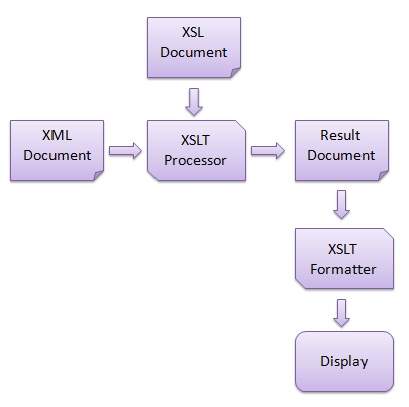
Advantages
Here are the advantages of using XSLT −
Independent of programming. Transformations are written in a separate xsl file which is again an XML document.
Output can be altered by simply modifying the transformations in xsl file. No need to change any code. So Web designers can edit the stylesheet and can see the change in the output quickly.
XSLT Syntax
Let’s suppose we have the following sample XML file, students.xml, which is required to be transformed into a well-formatted HTML document.
students.xml
<?xml version = "1.0"?>
<class>
<student rollno = "393">
<firstname>Dinkar</firstname>
<lastname>Kad</lastname>
<nickname>Dinkar</nickname>
<marks>85</marks>
</student>
<student rollno = "493">
<firstname>Vaneet</firstname>
<lastname>Gupta</lastname>
<nickname>Vinni</nickname>
<marks>95</marks>
</student>
<student rollno = "593">
<firstname>Jasvir</firstname>
<lastname>Singh</lastname>
<nickname>Jazz</nickname>
<marks>90</marks>
</student>
</class>
We need to define an XSLT style sheet document for the above XML document to meet the following criteria −
Page should have a title Students.
Page should have a table of student details.
Columns should have following headers: Roll No, First Name, Last Name, Nick Name, Marks
Table must contain details of the students accordingly.
Step 1: Create XSLT document
Create an XSLT document to meet the above requirements, name it as students.xsl and save it in the same location where students.xml lies.
students.xsl
<?xml version = "1.0" encoding = "UTF-8"?>
<!-- xsl stylesheet declaration with xsl namespace:
Namespace tells the xlst processor about which
element is to be processed and which is used for output purpose only
-->
<xsl:stylesheet version = "1.0"
xmlns:xsl = "http://www.w3.org/1999/XSL/Transform">
<!-- xsl template declaration:
template tells the xlst processor about the section of xml
document which is to be formatted. It takes an XPath expression.
In our case, it is matching document root element and will
tell processor to process the entire document with this template.
-->
<xsl:template match = "/">
<!-- HTML tags
Used for formatting purpose. Processor will skip them and browser
will simply render them.
-->
<html>
<body>
<h2>Students</h2>
<table border = "1">
<tr bgcolor = "#9acd32">
<th>Roll No</th>
<th>First Name</th>
<th>Last Name</th>
<th>Nick Name</th>
<th>Marks</th>
</tr>
<!-- for-each processing instruction
Looks for each element matching the XPath expression
-->
<xsl:for-each select="class/student">
<tr>
<td>
<!-- value-of processing instruction
process the value of the element matching the XPath expression
-->
<xsl:value-of select = "@rollno"/>
</td>
<td><xsl:value-of select = "firstname"/></td>
<td><xsl:value-of select = "lastname"/></td>
<td><xsl:value-of select = "nickname"/></td>
<td><xsl:value-of select = "marks"/></td>
</tr>
</xsl:for-each>
</table>
</body>
</html>
</xsl:template>
</xsl:stylesheet>
Step 2: Link the XSLT Document to the XML Document
Update student.xml document with the following xml-stylesheet tag. Set href value to students.xsl
<?xml version = "1.0"?> <?xml-stylesheet type = "text/xsl" href = "students.xsl"?> <class> ... </class>
Step 3: View the XML Document in Internet Explorer
students.xml
<?xml version = "1.0"?>
<?xml-stylesheet type = "text/xsl" href = "students.xsl"?>
<class>
<student rollno = "393">
<firstname>Dinkar</firstname>
<lastname>Kad</lastname>
<nickname>Dinkar</nickname>
<marks>85</marks>
</student>
<student rollno = "493">
<firstname>Vaneet</firstname>
<lastname>Gupta</lastname>
<nickname>Vinni</nickname>
<marks>95</marks>
</student>
<student rollno = "593">
<firstname>Jasvir</firstname>
<lastname>Singh</lastname>
<nickname>Jazz</nickname>
<marks>90</marks>
</student>
</class>
Output
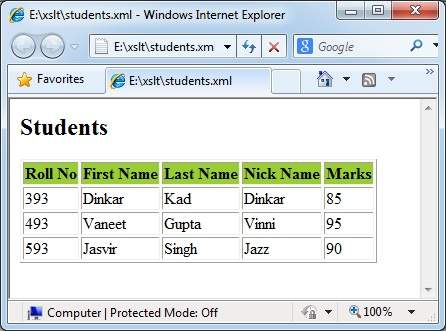
XSLT <template>
<xsl:template> defines a way to reuse templates in order to generate the desired output for nodes of a particular type/context.
Declaration
Following is the syntax declaration of <xsl:template> element.
<xsl:template name = Qname match = Pattern priority = number mode = QName > </xsl:template>
Attributes
| Sr.No | Name & Description |
|---|---|
| 1 | name Name of the element on which template is to be applied. |
| 2 | match Pattern which signifies the element(s) on which template is to be applied. |
| 3 | priority Priority number of a template. Matching template with low priority is not considered in from in front of high priority template. |
| 4 | mode Allows element to be processed multiple times to produce a different result each time. |
Elements
| Number of occurrences | Unlimited |
|---|---|
Parent elements |
xsl:stylesheet, xsl:transform |
Child elements |
xsl:apply-imports,xsl:apply-templates,xsl:attribute, xsl:call-template, xsl:choose, xsl:comment, xsl:copy, xsl:copy-of, xsl:element, xsl:fallback, xsl:for-each, xsl:if, xsl:message, xsl:number, xsl:param, xsl:processing-instruction, xsl:text, xsl:value-of, xsl:variable, output elements |
Demo Example
This template rule has a pattern that identifies <student> elements and produces an output in a tabular format.
students.xml
<?xml version = "1.0"?>
<?xml-stylesheet type = "text/xsl" href = "students.xsl"?>
<class>
<student rollno = "393">
<firstname>Dinkar</firstname>
<lastname>Kad</lastname>
<nickname>Dinkar</nickname>
<marks>85</marks>
</student>
<student rollno = "493">
<firstname>Vaneet</firstname>
<lastname>Gupta</lastname>
<nickname>Vinni</nickname>
<marks>95</marks>
</student>
<student rollno = "593">
<firstname>Jasvir</firstname>
<lastname>Singh</lastname>
<nickname>Jazz</nickname>
<marks>90</marks>
</student>
</class>
students_imports.xsl
<?xml version = "1.0" encoding = "UTF-8"?>
<xsl:stylesheet version = "1.0"
xmlns:xsl = "http://www.w3.org/1999/XSL/Transform">
<xsl:template match = "/">
<html>
<body>
<h2>Students</h2>
<table border = "1">
<tr bgcolor = "#9acd32">
<th>Roll No</th>
<th>First Name</th>
<th>Last Name</th>
<th>Nick Name</th>
<th>Marks</th>
</tr>
<xsl:for-each select = "class/student">
<tr>
<td><xsl:value-of select = "@rollno"/></td>
<td><xsl:value-of select = "firstname"/></td>
<td><xsl:value-of select = "lastname"/></td>
<td><xsl:value-of select = "nickname"/></td>
<td><xsl:value-of select = "marks"/></td>
</tr>
</xsl:for-each>
</table>
</body>
</html>
</xsl:template>
</xsl:stylesheet>
Output

XSLT <value-of>
<xsl:value-of> tag puts the value of the selected node as per XPath expression, as text.
Declaration
Following is the syntax declaration of <xsl:value-of> element.
<xsl:value-of select = Expression disable-output-escaping = "yes" | "no" > </xsl:value-of>
Attributes
| Sr.No | Name & Description |
|---|---|
| 1 | Select XPath Expression to be evaluated in current context. |
| 2 | disable-outputescaping Default-"no". If "yes", output text will not escape xml characters from text. |
Elements
| Number of Occurrences | Unlimited |
|---|---|
Parent elements |
xsl:attribute, xsl:comment, xsl:copy, xsl:element, xsl:fallback, xsl:for-each, xsl:if, xsl:message, xsl:otherwise, xsl:param, xsl:processing instruction, xsl:template, xsl:variable, xsl:when, xsl:with-param, output elements |
Child elements |
None |
Demo Example
This example creates a table of <student> element with its attribute rollno and its child <firstname>, <lastname>, <nickname>, and <marks>.
students.xml
<?xml version = "1.0"?>
<?xml-stylesheet type = "text/xsl" href = "students.xsl"?>
<class>
<student rollno = "393">
<firstname>Dinkar</firstname>
<lastname>Kad</lastname>
<nickname>Dinkar</nickname>
<marks>85</marks>
</student>
<student rollno = "493">
<firstname>Vaneet</firstname>
<lastname>Gupta</lastname>
<nickname>Vinni</nickname>
<marks>95</marks>
</student>
<student rollno = "593">
<firstname>Jasvir</firstname>
<lastname>Singh</lastname>
<nickname>Jazz</nickname>
<marks>90</marks>
</student>
</class>
students.xsl
<?xml version = "1.0" encoding = "UTF-8"?>
<xsl:stylesheet version = "1.0"
xmlns:xsl = "http://www.w3.org/1999/XSL/Transform">
<xsl:template match = "/">
<html>
<body>
<h2>Students</h2>
<table border = "1">
<tr bgcolor = "#9acd32">
<th>Roll No</th>
<th>First Name</th>
<th>Last Name</th>
<th>Nick Name</th>
<th>Marks</th>
</tr>
<xsl:for-each select = "class/student">
<tr>
<td><xsl:value-of select = "@rollno"/></td>
<td><xsl:value-of select = "firstname"/></td>
<td><xsl:value-of select = "lastname"/></td>
<td><xsl:value-of select = "nickname"/></td>
<td><xsl:value-of select = "marks"/></td>
</tr>
</xsl:for-each>
</table>
</body>
</html>
</xsl:template>
</xsl:stylesheet>
Verify the output

XSLT <for-each>
<xsl:for-each> tag applies a template repeatedly for each node.
Declaration
Following is the syntax declaration of <xsl:for-each> element
<xsl:for-each select = Expression > </xsl:for-each>
Attributes
| Sr.No | Name & Description |
|---|---|
| 1 | Select XPath Expression to be evaluated in current context to determine the set of nodes to be iterated. |
Elements
| Number of Occurrences | Unlimited |
|---|---|
Parent elements |
xsl:attribute, xsl:comment, xsl:copy, xsl:element, xsl:fallback, xsl:foreach, xsl:if, xsl:message, xsl:otherwise, xsl:param, xsl:processinginstruction, xsl:template, xsl:variable, xsl:when, xsl:with-param, output elements. |
Child elements |
xsl:apply-imports, xsl:apply-templates, xsl:attribute, xsl:call-template, xsl:choose, xsl:comment, xsl:copy, xsl:copy-of, xsl:element, xsl:fallback, xsl:for-each, xsl:if, xsl:message, xsl:number, xsl:processing-instruction, xsl:sort, xsl:text, xsl:value-of, xsl:variable. |
Demo Example
This example creates a table of <student> element with its attribute rollno and its child <firstname>,<lastname><nickname> and <marks> by iterating over each student.
students.xml
<?xml version = "1.0"?>
<?xml-stylesheet type = "text/xsl" href = "students.xsl"?>
<class>
<student rollno = "393">
<firstname>Dinkar</firstname>
<lastname>Kad</lastname>
<nickname>Dinkar</nickname>
<marks>85</marks>
</student>
<student rollno = "493">
<firstname>Vaneet</firstname>
<lastname>Gupta</lastname>
<nickname>Vinni</nickname>
<marks>95</marks>
</student>
<student rollno = "593">
<firstname>Jasvir</firstname>
<lastname>Singh</lastname>
<nickname>Jazz</nickname>
<marks>90</marks>
</student>
</class>
students.xsl
<?xml version = "1.0" encoding = "UTF-8"?>
<xsl:stylesheet version = "1.0"
xmlns:xsl = "http://www.w3.org/1999/XSL/Transform">
<xsl:template match = "/">
<html>
<body>
<h2>Students</h2>
<table border = "1">
<tr bgcolor = "#9acd32">
<th>Roll No</th>
<th>First Name</th>
<th>Last Name</th>
<th>Nick Name</th>
<th>Marks</th>
</tr>
<xsl:for-each select = "class/student">
<tr>
<td><xsl:value-of select = "@rollno"/></td>
<td><xsl:value-of select = "firstname"/></td>
<td><xsl:value-of select = "lastname"/></td>
<td><xsl:value-of select = "nickname"/></td>
<td><xsl:value-of select = "marks"/></td>
</tr>
</xsl:for-each>
</table>
</body>
</html>
</xsl:template>
</xsl:stylesheet>
Output

XSLT <sort>
<xsl:sort> tag specifies a sort criteria on the nodes.
Declaration
Following is the syntax declaration of <xsl:sort> element.
<xsl:sort
select = string-expression
lang = { nmtoken }
data-type = { "text" | "number" | QName }
order = { "ascending" | "descending" }
case-order = { "upper-first" | "lower-first" } >
</xsl:sort>
Attributes
| Sr.No | Name & Description |
|---|---|
| 1 | select Sorting key of the node. |
| 2 | lang Language alphabet used to determine sort order. |
| 3 | data-type Data type of the text. |
| 4 | order Sorting order. Default is "ascending". |
| 5 | case-order Sorting order of string by capitalization. Default is "upper-first". |
Elements
| Number of occurrences | Unlimited |
| Parent elements | xsl:apply-templates, xsl:for-each |
| Child elements | None |
Demo Example
This example creates a table of <student> element with its attribute rollno and its child <firstname>, <lastname>, <nickname>, and <marks> by iterating over each student sort them by first name.
students.xml
<?xml version = "1.0"?>
<?xml-stylesheet type = "text/xsl" href = "students.xsl"?>
<class>
<student rollno = "393">
<firstname>Dinkar</firstname>
<lastname>Kad</lastname>
<nickname>Dinkar</nickname>
<marks>85</marks>
</student>
<student rollno = "493">
<firstname>Vaneet</firstname>
<lastname>Gupta</lastname>
<nickname>Vinni</nickname>
<marks>95</marks>
</student>
<student rollno = "593">
<firstname>Jasvir</firstname>
<lastname>Singh</lastname>
<nickname>Jazz</nickname>
<marks>90</marks>
</student>
</class>
students.xsl
<?xml version = "1.0" encoding = "UTF-8"?>
<xsl:stylesheet version = "1.0"
xmlns:xsl = "http://www.w3.org/1999/XSL/Transform">
<xsl:template match = "/">
<html>
<body>
<h2>Students</h2>
<table border = "1">
<tr bgcolor = "#9acd32">
<th>Roll No</th>
<th>First Name</th>
<th>Last Name</th>
<th>Nick Name</th>
<th>Marks</th>
</tr>
<xsl:for-each select = "class/student">
<xsl:sort select = "firstname"/>
<tr>
<td><xsl:value-of select = "@rollno"/></td>
<td><xsl:value-of select = "firstname"/></td>
<td><xsl:value-of select = "lastname"/></td>
<td><xsl:value-of select = "nickname"/></td>
<td><xsl:value-of select = "marks"/></td>
</tr>
</xsl:for-each>
</table>
</body>
</html>
</xsl:template>
</xsl:stylesheet>
Output
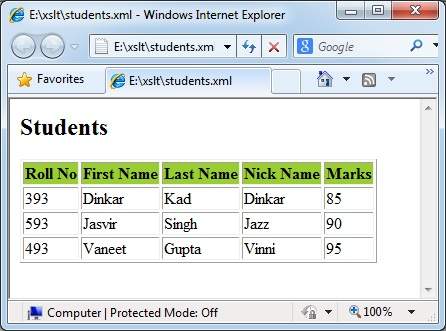
XSLT <if>
<xsl:if> tag specifies a conditional test against the content of nodes.
Declaration
Following is the syntax declaration of <xsl:if> element.
<xsl:if test = boolean-expression > </xsl:if>
Attributes
| Sr.No | Name & Description |
|---|---|
| 1 | test The condition in the xml data to test. |
Elements
| Number of Occurrences | Unlimited |
|---|---|
Parent elements | xsl:attribute, xsl:comment, xsl:copy, xsl:element, xsl:fallback, xsl:for-each, xsl:if, xsl:message, xsl:otherwise, xsl:param, xsl:processing-instruction, xsl:template, xsl:variable, xsl:when, xsl:with-param, output elements |
Child elements | xsl:apply-templates, xsl:attribute, xsl:call-template, xsl:choose, xsl:comment, xsl:copy, xsl:copy-of, xsl:element, xsl:for-each, xsl:if, xsl:processing-instruction, xsl:text, xsl:value-of, xsl:variable, output elements |
Demo Example
This example creates a table of <student> element with its attribute rollno and its child <firstname>, <lastname>, <nickname>, and <marks> by iterating over each student. It checks marks to be greater than 90 and then prints the student(s) details.
students.xml
<?xml version = "1.0"?>
<?xml-stylesheet type = "text/xsl" href = "students.xsl"?>
<class>
<student rollno = "393">
<firstname>Dinkar</firstname>
<lastname>Kad</lastname>
<nickname>Dinkar</nickname>
<marks>85</marks>
</student>
<student rollno = "493">
<firstname>Vaneet</firstname>
<lastname>Gupta</lastname>
<nickname>Vinni</nickname>
<marks>95</marks>
</student>
<student rollno = "593">
<firstname>Jasvir</firstname>
<lastname>Singh</lastname>
<nickname>Jazz</nickname>
<marks>90</marks>
</student>
</class>
students.xsl
<?xml version = "1.0" encoding = "UTF-8"?>
<xsl:stylesheet version = "1.0"
xmlns:xsl = "http://www.w3.org/1999/XSL/Transform">
<xsl:template match = "/">
<html>
<body>
<h2>Students</h2>
<table border = "1">
<tr bgcolor = "#9acd32">
<th>Roll No</th>
<th>First Name</th>
<th>Last Name</th>
<th>Nick Name</th>
<th>Marks</th>
</tr>
<xsl:for-each select = "class/student">
<xsl:if test = "marks > 90">
<tr>
<td><xsl:value-of select = "@rollno"/></td>
<td><xsl:value-of select = "firstname"/></td>
<td><xsl:value-of select = "lastname"/></td>
<td><xsl:value-of select = "nickname"/></td>
<td><xsl:value-of select = "marks"/></td>
</tr>
</xsl:if>
</xsl:for-each>
</table>
</body>
</html>
</xsl:template>
</xsl:stylesheet>
Output

XSLT <choose>
<xsl:choose> tag specifies a multiple conditional tests against the content of nodes in conjunction with the <xsl:otherwise> and <xsl:when> elements.
Declaration
Following is the syntax declaration of <xsl:choose> element.
<xsl:choose > </xsl:choose>
Elements
| Number of Occurrences | Unlimited |
|---|---|
Parent elements |
xsl:attribute, xsl:comment, xsl:copy, xsl:element, xsl:fallback, xsl:for-each, xsl:if, xsl:message, xsl:otherwise, xsl:param, xsl:processing-instruction, xsl:template, xsl:variable, xsl:when, xsl:with-param, output elements |
Child elements |
xsl:otherwise, xsl:when |
Demo Example
This example creates a table of <student> element with its attribute rollno and its child <firstname>, <lastname>, <nickname>, and <marks> by iterating over each student. It checks and then prints the grade details.
students.xml
<?xml version = "1.0"?>
<?xml-stylesheet type = "text/xsl" href = "students.xsl"?>
<class>
<student rollno = "393">
<firstname>Dinkar</firstname>
<lastname>Kad</lastname>
<nickname>Dinkar</nickname>
<marks>85</marks>
</student>
<student rollno = "493">
<firstname>Vaneet</firstname>
<lastname>Gupta</lastname>
<nickname>Vinni</nickname>
<marks>95</marks>
</student>
<student rollno = "593">
<firstname>Jasvir</firstname>
<lastname>Singh</lastname>
<nickname>Jazz</nickname>
<marks>90</marks>
</student>
</class>
students.xsl
<?xml version = "1.0" encoding = "UTF-8"?>
<xsl:stylesheet version = "1.0"
xmlns:xsl = "http://www.w3.org/1999/XSL/Transform">
<xsl:template match = "/">
<html>
<body>
<h2>Students</h2>
<table border = "1">
<tr bgcolor = "#9acd32">
<th>Roll No</th>
<th>First Name</th>
<th>Last Name</th>
<th>Nick Name</th>
<th>Marks</th>
<th>Grade</th>
</tr>
<xsl:for-each select = "class/student">
<tr>
<td><xsl:value-of select = "@rollno"/></td>
<td><xsl:value-of select = "firstname"/></td>
<td><xsl:value-of select = "lastname"/></td>
<td><xsl:value-of select = "nickname"/></td>
<td><xsl:value-of select = "marks"/></td>
<td>
<xsl:choose>
<xsl:when test = "marks > 90">
High
</xsl:when>
<xsl:when test = "marks > 85">
Medium
</xsl:when>
<xsl:otherwise>
Low
</xsl:otherwise>
</xsl:choose>
</td>
</tr>
</xsl:for-each>
</table>
</body>
</html>
</xsl:template>
</xsl:stylesheet>
Output

XSLT <key>
<xsl:key> tag element specifies a named name-value pair assigned to a specific element in an XML document. This key is used with the key() function in XPath expressions to access the assigned elements in an XML document.
Declaration
Following is the syntax declaration of <xsl:key> element.
<xsl:key name = QName match = Pattern use = Expression > </xsl:key>
Attributes
| S.No | Name & Description |
|---|---|
| 1 | Name Name of the key to be used. |
| 2 | Match Patterns used to identify a node that holds this key. |
| 3 | Use XPath expression to identify the value of the nodes of xml document. |
Elements
| Number of Occurrences | Unlimited |
| Parent elements | xsl:stylesheet |
| Child elements | None |
Demo Example
This example creates a table of <student> element with its attribute rollno and its child <firstname>, <lastname>, <nickname>, and <marks> by iterating over each student. It checks key as firstname to be one of the student's name and then prints the student details.
students.xml
<?xml version = "1.0"?>
<?xml-stylesheet type = "text/xsl" href = "students.xsl"?>
<class>
<student rollno = "393">
<firstname>Dinkar</firstname>
<lastname>Kad</lastname>
<nickname>Dinkar</nickname>
<marks>85</marks>
</student>
<student rollno = "493">
<firstname>Vaneet</firstname>
<lastname>Gupta</lastname>
<nickname>Vinni</nickname>
<marks>95</marks>
</student>
<student rollno = "593">
<firstname>Jasvir</firstname>
<lastname>Singh</lastname>
<nickname>Jazz</nickname>
<marks>90</marks>
</student>
</class>
students.xsl
<xsl:stylesheet version = "1.0"
xmlns:xsl = "http://www.w3.org/1999/XSL/Transform">
<xsl:key name = "firstname-search" match = "student" use = "firstname"/>
<xsl:template match = "/">
<html>
<body>
<h2>Students</h2>
<table border = "1">
<tr bgcolor = "#9acd32">
<th>Roll No</th>
<th>First Name</th>
<th>Last Name</th>
<th>Nick Name</th>
<th>Marks</th>
</tr>
<xsl:for-each select = "key('firstname-search', 'Dinkar')">
<tr>
<td><xsl:value-of select = "@rollno"/></td>
<td><xsl:value-of select = "firstname"/></td>
<td><xsl:value-of select = "lastname"/></td>
<td><xsl:value-of select = "nickname"/></td>
<td><xsl:value-of select = "marks"/></td>
</tr>
</xsl:for-each>
</table>
</body>
</html>
</xsl:template>
</xsl:stylesheet>
Output
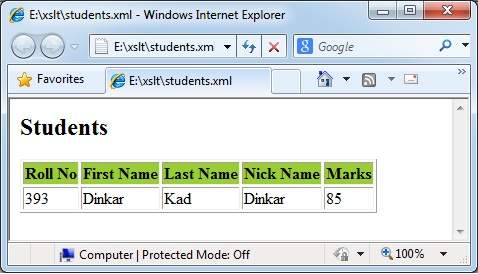
XSLT <message>
<message> tag element helps to debug an XSLT processing. It is similar to javascript alerts. <xsl:> tag buffers a message to XSLT processor which terminates the processing and sends a message to the caller application to display the error message.
Declaration
Following is the syntax declaration of <xsl:message> element.
<xsl:message terminate = "yes" | "no" > </xsl:message>
Attributes
| Sr.No | Name & Description |
|---|---|
| 1 | terminate It specifies whether the transformation should terminate upon executing this instruction or not. Default is "yes". |
Elements
| Number of Occurrences | Unlimited |
|---|---|
| Parent elements | xsl:attribute, xsl:comment, xsl:copy, xsl:element, xsl:fallback, xsl:foreach, xsl:if, xsl:message, xsl:otherwise, xsl:param, xsl:processinginstruction, xsl:template, xsl:variable, xsl:when, xsl:with-param, output elements |
Child elements |
xsl:apply-templates, xsl:attribute, xsl:call-template, xsl:choose, xsl:comment, xsl:copy, xsl:copy-of, xsl:element, xsl:for-each, xsl:if, xsl:processing-instruction, xsl:text, xsl:value-of, xsl:variable, output elements |
Demo Example
This example creates a table of <student> element with its attribute rollno and its child <firstname>, <lastname>, <nickname>, and <marks> by iterating over each student. It checks key as firstname to be present and then prints the student details, otherwise displays an error message.
students.xml
<?xml version = "1.0"?>
<?xml-stylesheet type = "text/xsl" href = "students.xsl"?>
<class>
<student rollno = "393">
<firstname>Dinkar</firstname>
<lastname>Kad</lastname>
<nickname>Dinkar</nickname>
<marks>85</marks>
</student>
<student rollno = "493">
<firstname></firstname>
<lastname>Gupta</lastname>
<nickname>Vinni</nickname>
<marks>95</marks>
</student>
<student rollno = "593">
<firstname>Jasvir</firstname>
<lastname>Singh</lastname>
<nickname>Jazz</nickname>
<marks>90</marks>
</student>
</class>
students.xsl
<?xml version = "1.0" encoding = "UTF-8"?>
<xsl:stylesheet version = "1.0"
xmlns:xsl = "http://www.w3.org/1999/XSL/Transform">
<xsl:template match = "/">
<html>
<body>
<h2>Students</h2>
<table border = "1">
<tr bgcolor = "#9acd32">
<th>Roll No</th>
<th>First Name</th>
<th>Last Name</th>
<th>Nick Name</th>
<th>Marks</th>
</tr>
<xsl:for-each select = "class/student">
<xsl:if test = "firstname = ''">
<xsl:message terminate = "yes">A first name field is empty.
</xsl:message>
</xsl:if>
<tr>
<td><xsl:value-of select = "@rollno"/></td>
<td><xsl:value-of select = "firstname"/></td>
<td><xsl:value-of select = "lastname"/></td>
<td><xsl:value-of select = "nickname"/></td>
<td><xsl:value-of select = "marks"/></td>
</tr>
</xsl:for-each>
</table>
</body>
</html>
</xsl:template>
</xsl:stylesheet>
Output
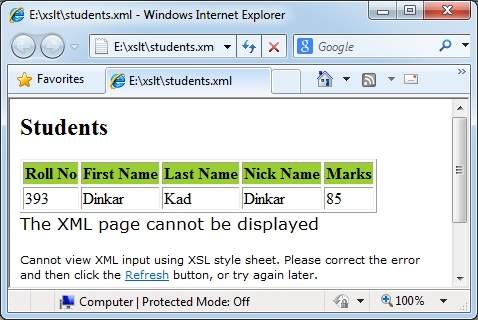
XSLT <apply-template>
<xsl:apply-template> tag signals the XSLT processor to find the appropriate template to apply, based on the type and context of each selected node.
Declaration
Following is the syntax declaration of <xsl:apply-template> element.
<xsl:apply-template select = Expression mode = QName > </xsl:apply-template>
Attributes
| Sr.No | Name & Description |
|---|---|
| 1 | select Used to process nodes selected by an XPath expression, instead of processing all the children. |
| 2 | mode Allows an element as specified by its Qualified Names to be processed multiple times, each time producing a different result. |
Elements
| Number of occurrences | Unlimited |
|---|---|
Parent elements |
xsl:attribute, xsl:comment, xsl:copy, xsl:element, xsl:fallback, xsl:foreach, xsl:if, xsl:message, xsl:otherwise, xsl:param, xsl:processinginstruction, xsl:template, xsl:variable, xsl:when, xsl:with-param, output elements |
Child elements |
xsl:sort, xsl:with-param |
Demo Example
This example creates a list of <student> element with its attribute rollno and its child <firstname>, <lastname>, <nickname>, and <marks> by iterating over each student.
students.xml
<?xml version = "1.0"?>
<?xml-stylesheet type = "text/xsl" href = "students.xsl"?>
<class>
<student rollno = "393">
<firstname>Dinkar</firstname>
<lastname>Kad</lastname>
<nickname>Dinkar</nickname>
<marks>85</marks>
</student>
<student rollno = "493">
<firstname>Vaneet</firstname>
<lastname>Gupta</lastname>
<nickname>Vinni</nickname>
<marks>95</marks>
</student>
<student rollno = "593">
<firstname>Jasvir</firstname>
<lastname>Singh</lastname>
<nickname>Jazz</nickname>
<marks>90</marks>
</student>
</class>
students.xsl
<?xml version = "1.0" encoding = "UTF-8"?>
<xsl:stylesheet version = "1.0"
xmlns:xsl = "http://www.w3.org/1999/XSL/Transform">
<xsl:template match = "/">
<html>
<body>
<h2>Students</h2>
<xsl:apply-templates select = "class/student" />
</body>
</html>
</xsl:template>
<xsl:template match = "class/student">
<xsl:apply-templates select = "@rollno" />
<xsl:apply-templates select = "firstname" />
<xsl:apply-templates select = "lastname" />
<xsl:apply-templates select = "nickname" />
<xsl:apply-templates select = "marks" />
<br />
</xsl:template>
<xsl:template match = "@rollno">
<span style = "font-size = 22px;">
<xsl:value-of select = "." />
</span>
<br />
</xsl:template>
<xsl:template match = "firstname">
First Name:<span style = "color:blue;">
<xsl:value-of select = "." />
</span>
<br />
</xsl:template>
<xsl:template match = "lastname">
Last Name:<span style = "color:green;">
<xsl:value-of select = "." />
</span>
<br />
</xsl:template>
<xsl:template match = "nickname">
Nick Name:<span style = "color:red;">
<xsl:value-of select = "." />
</span>
<br />
</xsl:template>
<xsl:template match = "marks">
Marks:<span style = "color:gray;">
<xsl:value-of select = "." />
</span>
<br />
</xsl:template>
</xsl:stylesheet>
Output
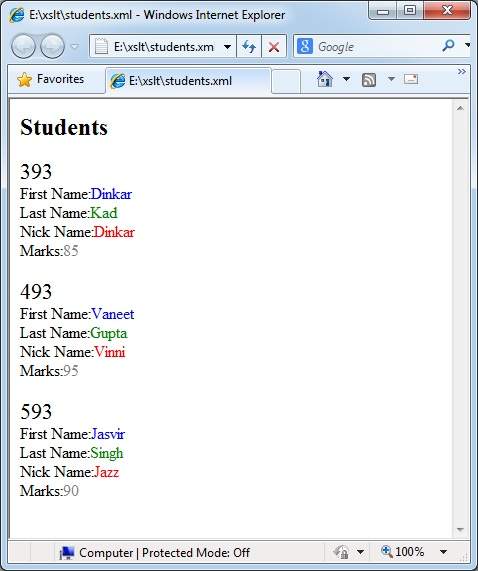
XSLT <import>
<xsl:import> tag imports the contents of one stylesheet into another. Importing a style sheet has higher precedence over imported stylesheet.
Declaration
Following is the syntax declaration of <xsl:import> element.
<xsl:import href = "uri"> </xsl:import>
Attributes
| Sr.No | Name & Description |
|---|---|
| 1. | href used to pass the path of xslt stylesheet to be imported . |
Elements
| Number of occurrences | Unlimited |
| Parent elements | xsl:stylesheet, xsl:transform |
| Child elements | none |
Demo Example
This example creates a list of <student> element with its attribute rollno and its child <firstname>, <lastname>, <nickname>, and <marks> by iterating over each student. Here we have created two xsl stylesheets where students_imports.xsl stylesheet imports students.xsl and students.xml is linked to students_imports.xsl.
students.xml
<?xml version = "1.0"?>
<?xml-stylesheet type = "text/xsl" href = "students_imports.xsl"?>
<class>
<student rollno = "393">
<firstname>Dinkar</firstname>
<lastname>Kad</lastname>
<nickname>Dinkar</nickname>
<marks>85</marks>
</student>
<student rollno = "493">
<firstname>Vaneet</firstname>
<lastname>Gupta</lastname>
<nickname>Vinni</nickname>
<marks>95</marks>
</student>
<student rollno = "593">
<firstname>Jasvir</firstname>
<lastname>Singh</lastname>
<nickname>Jazz</nickname>
<marks>90</marks>
</student>
</class>
students.xsl
<?xml version = "1.0" encoding = "UTF-8"?>
<xsl:stylesheet version = "1.0"
xmlns:xsl = "http://www.w3.org/1999/XSL/Transform">
<xsl:template match = "/">
<html>
<body>
<h2>Students</h2>
<table border = "1">
<tr bgcolor = "#9acd32">
<th>Roll No</th>
<th>First Name</th>
<th>Last Name</th>
<th>Nick Name</th>
<th>Marks</th>
</tr>
<xsl:for-each select = "class/student">
<tr>
<td><xsl:value-of select = "@rollno"/></td>
<td><xsl:value-of select = "firstname"/></td>
<td><xsl:value-of select = "lastname"/></td>
<td><xsl:value-of select = "nickname"/></td>
<td><xsl:value-of select = "marks"/></td>
</tr>
</xsl:for-each>
</table>
</body>
</html>
</xsl:template>
</xsl:stylesheet>
students_imports.xsl
<?xml version = "1.0" encoding = "UTF-8"?>
<xsl:stylesheet version = "1.0"
xmlns:xsl = "http://www.w3.org/1999/XSL/Transform">
<xsl:import href = "students.xsl"/>
<xsl:template match = "/">
<xsl:apply-imports/>
</xsl:template>
</xsl:stylesheet>
Output
